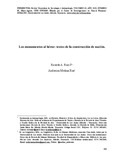Los monumentos al héroe: textos de la construcción de nación

View/
Date
2020-12-11Palabras Clave
Monumento, texto, héroe nacional, identidad, habitusMonument, text, national hero, identity, habitus
Metadata
Show full item recordAbstract
Este ejercicio de análisisaborda tres monumentos erigidos en la ciudad de Mérida (Venezuela), a héroes de la gesta independentista entre 1842 y 1895: la columna de Bolívar (1842), la columna de Páez (1890), el monumento a Sucre (1895). Además de objetos estéticos, estos monumentos llevan desde su concepción la construcción de un tipo de nación y un tipo de ciudad deseada, igualmente de la construcciónde la ciudadanía moderna a partir de lo patrimonial. Bajo este propósito se consideró superar especificidadesdisciplinares, para alcanzar una interpretación razonada de la motivación del levantamiento de estas obras.Por consiguiente, destacan entre los autores: Derrida desde la deconstrucción, y su concepto de texto como estructura leída de la realidad yBourdieu al tomar de su propuesta teórica las nociones de campo, capital y habitus. Entre los hallazgos más relevantes, destacará que tales hitos pertenecen al discurso extenso de la construcción de nación a través de la creación de un ciudadano ejemplar, como parte del Proyecto Nacional, lo que también incluía la necesidad de ordenamiento urbano por medio de parques y monumentos embebidos de ese espíritu con la finalidad homogeneizadora de la sociedad.
Collections
Información Adicional
| Otros Títulos | Monuments to the Hero: Nation Building Texts |
| Correo Electrónico | ricruizjr@gmail.com anderzonmedina@gmail.com |
| ISSN | 0798-3069 |
| Resumen en otro Idioma | This research exercise addresses three monuments in the city of Mérida (Venezuela), to heroes of the Venezuelan war of independence. Built between 1842 and 1895, these monuments are the Columna de Bolívar (1842), the Columna de Páez (1890), the Monument to Sucre (1895). More than aesthetic objects, these monuments convey the construction of a kind of nation and a kind of city, in addition to the construction of modern citizenship based on national heritage. The analysis overcomes disciplinary boundaries in order to reach a plausible interpretation of the motivation for the building of these works. Two authors stand out: Derrida for a deconstructive approach, along with his concept of text as any structure read from reality and Bourdieu, from whomwe take the notions of field, capital and habitus. As a relevant finding, we point out thatthesemonuments belong to angreater discourse for constructing nation through the creation of exemplary citizens, as part of anational project, which also included the need for urban planning (through parks and monuments)permeated with astandardizing purpose. |
| Colación | 485-511 |
| Periodicidad | Cuatrimestral |
| Página Web | www.saber.ula.ve/fermentum |
| País | Venezuela |
| Institución | Universidad de Los Andes |
| Sección | Fermentum: Artículos |





